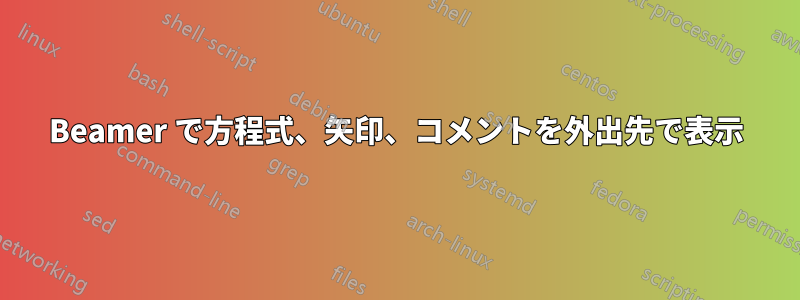
私は、tikZとbeamerを組み合わせて方程式を強調表示する方法が好きです(beamerarticleやarticleモードでもうまく機能します)。TeXの例この機能をよく使用しますが、コードを「外出先で」操作するのは難しいと思います。コード内で簡単に呼び出せるnewcommand(?) (方程式とコメント) を作成したいと思います。\EqNComments
\EqNComments
{$\Delta$}{=}{Le point Delta}
{$\mathcal{N}(d_1)$}{+}{Hedge ratio}
{$K.e^{-rt}.\mathcal{N}(d_2)$}{}{Strike actualised}
こちらは 3x3 要素で非常にうまく機能する MWE です。
newcommandパラメータの9の制限に悩まされています\foreachコードを最適化するために入力するのが難しいこの問題を処理するにはもっと賢い方法があるはずだ...
\documentclass{beamer} %\documentclass[11pt,twoside]{article} %\usepackage[envcountsect]{beamerarticle} \usetheme{Warsaw} \usepackage{amsmath} \usepackage{amssymb} \usepackage{tikz} \usetikzlibrary{arrows,shapes} \tikzset{ Col1/.style= {fill=blue!20,anchor=base,rounded corners=2pt}, Col2/.style= {Col1, fill=red!20}, Col3/.style= {Col1, fill=green!20}, } \newcommand{\EqNComments}[9] { \tikzstyle{every picture}+=[remember picture] \tikzstyle{na} = [baseline=-.5ex] \begin{frame} \begin{equation} \tikz[baseline] {\node[Col1] (d1) {#1};} #2 \tikz[baseline] {\node[Col2] (d2) {#4};} #5 \tikz[baseline] {\node[Col3] (d3) {#7};} #8 % \tikz[baseline] {\node[Col3] (d4) {#10};} #11 \end{equation} \begin{itemize} \item #3 \tikz[na] \node[coordinate] (s1) {}; \item #6 \tikz[na] \node[coordinate] (s2) {}; \item #9 \tikz[na] \node[coordinate] (s3) {}; % \item #12 % \tikz[na] \node[coordinate] (s4) {}; \end{itemize} \begin{tikzpicture}[overlay] \path[->] (s1) edge [bend left] (d1); \path[->] (s2) edge [bend right] (d2); \path[->] (s3) edge [out=0, in=-90] (d3); % \path[->] (s4) edge [out=0, in=-90] (d4); \end{tikzpicture} \end{frame} } \begin{document} \EqNComments {$\Delta$}{=}{Le point Delta} {$\mathcal{N}(d_1)$}{+}{Hedge ratio} {$K.e^{-rt}.\mathcal{N}(d_2)$}{-}{Strike actualised} %{dividendes}{.}{Not working here if I try to extend the command to 12 arguments} \end{document}
答え1
これはそのようなことを行います。tikzmarkライブラリを使用しますが、これはスペースを破壊せず、モードを検出できるため、より優れたツールです。任意の量を注釈で付けることができます。
\tmn{<quantity>}{<annotation>}
これらを環境に配置するとAnnotatedEquation、実行しているのと同様にリストによって注釈が付けられます。ノードは、定義されている範囲でスタイルなどを使用しますCol1。Col2オプションの引数を使用して、いくつかのキーを追加できます。
\documentclass{beamer}
\usepackage{tikz}
\usetikzlibrary{tikzmark}
\newcounter{mytn}
\makeatletter
\newcommand{\tmn}[3][]{\stepcounter{mytn}%
\tikzmarknode[Col\the\numexpr\value{mytn}-\mytn@start\relax/.try,inner xsep=2pt,%
minimum height=1.6em,#1]{mytn-\number\value{mytn}}{#2}%
\expandafter\gdef\csname tmn@annot@\number\value{mytn}\endcsname{#3}}
\newenvironment{AnnotatedEquation}{\edef\mytn@start{\number\value{mytn}}%
\begin{equation}}{\end{equation}%
\edef\mytn@end{\number\value{mytn}}%
\ifnum\mytn@end>\mytn@start
\begin{itemize}
\foreach \X in {\the\numexpr\mytn@start+1,...,\mytn@end}
{\item \tikzmarknode{mytn-annot-\X}{\csname tmn@annot@\X\endcsname}%
\begin{tikzpicture}[overlay,remember picture]
\draw[-stealth] (mytn-annot-\X.east) to[out=0,in=-90] (mytn-\X.south);
\end{tikzpicture}}
\end{itemize}
\fi}
\makeatother
\tikzset{ Col1/.style= {fill=blue!20,anchor=base,rounded corners=2pt},
Col2/.style= {Col1, fill=red!20},
Col3/.style= {Col1, fill=green!20}, }
\begin{document}
\begin{frame}[t]
\frametitle{Some annotated equation}
\begin{AnnotatedEquation}
\tmn{\Delta}{Le point Delta}= \tmn{\mathcal{N}(d_1)}{Hedge ratio}-
\tmn{K\cdot \mathrm{e}^{-r\,t}\cdot\mathcal{N}(d_2)}{Strike actualised}
\end{AnnotatedEquation}
\end{frame}
\begin{frame}[t]
\frametitle{Another annotated equation}
\begin{AnnotatedEquation}
\tmn{\Delta}{Le point Delta}= \tmn{\mathcal{N}(d_1)}{Hedge ratio}-
\tmn{K\cdot \mathrm{e}^{-r\,t}\cdot\mathcal{N}(d_2)}{Strike actualised}
+\tmn{\xi}{a Weyl spinor}
+\tmn{\eta}{another Weyl spinor}
\end{AnnotatedEquation}
\end{frame}
\end{document}
で動作するバージョンはこちらですexternal。
\documentclass{beamer}
\usepackage{tikz}
\usetikzlibrary{tikzmark,external}
\newcounter{mytn}
\makeatletter
\newcommand{\tmn}[3][]{\stepcounter{mytn}%
\tikzmarknode[Col\the\numexpr\value{mytn}-\mytn@start\relax/.try,inner xsep=2pt,%
minimum height=1.6em,#1]{mytn-\number\value{mytn}}{#2}%
\expandafter\gdef\csname tmn@annot@\number\value{mytn}\endcsname{#3}}
\newenvironment{AnnotatedEquation}{\edef\mytn@start{\number\value{mytn}}%
\tikzexternaldisable
\begin{equation}}{\end{equation}%
\edef\mytn@end{\number\value{mytn}}%
\ifnum\mytn@end>\mytn@start
\begin{itemize}
\foreach \X in {\the\numexpr\mytn@start+1,...,\mytn@end}
{\item \tikzmarknode{mytn-annot-\X}{\csname tmn@annot@\X\endcsname}%
\begin{tikzpicture}[overlay,remember picture]
\draw[-stealth] (mytn-annot-\X.east) to[out=0,in=-90] (mytn-\X.south);
\end{tikzpicture}}
\end{itemize}
\fi\tikzexternalenable}
\makeatother
\tikzset{ Col1/.style= {fill=blue!20,anchor=base,rounded corners=2pt},
Col2/.style= {Col1, fill=red!20},
Col3/.style= {Col1, fill=green!20}, }
\begin{document}
\begin{frame}[t]
\frametitle{Some annotated equation}
\begin{AnnotatedEquation}
\tmn{\Delta}{Le point Delta}= \tmn{\mathcal{N}(d_1)}{Hedge ratio}-
\tmn{K\cdot \mathrm{e}^{-r\,t}\cdot\mathcal{N}(d_2)}{Strike actualised}
\end{AnnotatedEquation}
\end{frame}
\begin{frame}[t]
\frametitle{Another annotated equation}
\begin{AnnotatedEquation}
\tmn{\Delta}{Le point Delta}= \tmn{\mathcal{N}(d_1)}{Hedge ratio}-
\tmn{K\cdot \mathrm{e}^{-r\,t}\cdot\mathcal{N}(d_2)}{Strike actualised}
+\tmn{\xi}{a Weyl spinor}
+\tmn{\eta}{another Weyl spinor}
\end{AnnotatedEquation}
\end{frame}
\end{document}
付録: これはより複雑だがより一般的なバージョンで、矢印を調整することができます。これはspecial arrowキーを使用して行うことができます。たとえば、
\tmn[special arrow={out=90,annotations/out anchor=north}]{\Delta}{Le point Delta}= \tmn{\mathcal{N}(d_1)}{Hedge ratio}
矢印が注釈テキストの北から出て、90 度の角度で出るよう指示します。デフォルトは東のアンカーと 0 度です。これは分数の分子を扱うときに特に役立ちます。
\documentclass{beamer}
\usepackage{tikz}
\usetikzlibrary{tikzmark,external}
\newcounter{mytn}
\makeatletter
\newcommand{\tmn}[3][]{\stepcounter{mytn}%
\tikzmarknode[annotations/Col\the\numexpr\value{mytn}-\mytn@start\relax/.try,inner xsep=2pt,%
minimum height=1.6em,#1]{mytn-\number\value{mytn}}{#2}%
\expandafter\gdef\csname tmn@annot@\number\value{mytn}\endcsname{#3}}
\tikzset{special arrow/.code={%
\expandafter\xdef\csname tmn@arrow@style@\number\value{mytn}\endcsname{#1}}}
\newenvironment{AnnotatedEquation}{\edef\mytn@start{\number\value{mytn}}%
\tikzexternaldisable
\begin{equation}}{\end{equation}%
\edef\mytn@end{\number\value{mytn}}%
\ifnum\mytn@end>\mytn@start
\begin{itemize}
\foreach \X in {\the\numexpr\mytn@start+1,...,\mytn@end}
{\item \tikzmarknode{mytn-annot-\X}{\csname tmn@annot@\X\endcsname}%
\begin{tikzpicture}[overlay,remember picture]
\ifcsname tmn@arrow@style@\X\noexpand\endcsname
\draw[-stealth,out=0,in=-90,
style/.expanded=\csname tmn@arrow@style@\X\noexpand\endcsname]
(mytn-annot-\X.\pgfkeysvalueof{/tikz/annotations/out anchor})
to (mytn-\X.\pgfkeysvalueof{/tikz/annotations/in anchor});
\else
\draw[-stealth,out=0,in=-90] (mytn-annot-\X.\pgfkeysvalueof{/tikz/annotations/out anchor})
to (mytn-\X.\pgfkeysvalueof{/tikz/annotations/in anchor});
\fi
\end{tikzpicture}}
\end{itemize}
\fi\tikzexternalenable}
\makeatother
\tikzset{annotations/.cd,
Col1/.style= {fill=blue!20,anchor=base,rounded corners=2pt},
Col2/.style= {annotations/Col1, fill=red!20},
Col3/.style= {annotations/Col1, fill=green!20},
in anchor/.initial=south,out anchor/.initial=east}
\begin{document}
\begin{frame}[t]
\frametitle{Some annotated equation}
\begin{AnnotatedEquation}
\tmn{\Delta}{Le point Delta}= \tmn{\mathcal{N}(d_1)}{Hedge ratio}-
\tmn{K\cdot \mathrm{e}^{-r\,t}\cdot\mathcal{N}(d_2)}{Strike actualised}
\end{AnnotatedEquation}
\end{frame}
\begin{frame}[t]
\frametitle{Another annotated equation}
\begin{AnnotatedEquation}
\tmn[special arrow={out=90,annotations/out anchor=north}]{\Delta}{Le point Delta}= \tmn{\mathcal{N}(d_1)}{Hedge ratio}-
\tmn{K\cdot \mathrm{e}^{-r\,t}\cdot\mathcal{N}(d_2)}{Strike actualised}
+\frac{\tmn[special arrow={in=-160,annotations/in anchor=west}]{\xi}{a Weyl spinor}}{\tmn{\eta}{another Weyl spinor}}
\end{AnnotatedEquation}
\end{frame}
\end{document}
さらなる改善は可能ですが、実際にこれを使用しているユーザーからの意見が必要です。





